|
|
Advertisement:
|
|
ABIT Fatal1ty AA8XE i925XE LGA775 Motherboard |
|
Join the community - in the OCAU Forums!
|
Stable Overclocking, Conclusions, Final Thoughts
The next objective was to find the highest processor frequency at which each motheboard would run 100% stable. We decided to settle for nothing less than 24-hour stability with the processor running constantly at 100% load. For this purpose we invoked 2 instances of the Folding@Home client. F@H is a distributed computing project. It studies protein folding, misfolding, aggregation and related diseases. It uses large scale distributed computing to simulate timescales thousands to millions of times longer than previously achieved. Small work units of a research project are downloaded and, after the calculation has been done, are returned to the project server. Calculating two folding units at the same time puts 100% load on both virtual CPUs if HyperThreading is enabled. Besides contributing to a good cause, F@H is therefore a great CPU and system stability test.
After experimenting for several days with various voltage and frequency combinations we finally found the AA8XE would run stably for 24 hours with constant 100% processor usage at 4.39 GHz and 1.60 volt.
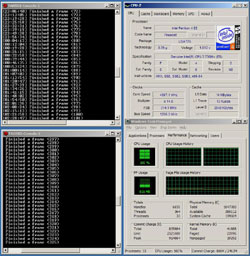
The P5AD2-E crashed at this same frequency after 30 to 45 minutes. The reason is obviously overheating. The heatsinks on the mosfets and on the Northbridge don’t have active, forced-air cooling. Above 4.00 GHz and full system load these heatsinks and the area around them are getting increasingly hot, and above 4.10 GHz it‘s impossible to touch their surface without getting burnt fingers. ASUS is advertising the P5AD2-E solution as “fanless design – zero noise - no moving parts” as it is written on the mosfet heatsink. Well, that’s correct, but it becomes a problem if the P5AD2-E is running overclocked for a longer period of time.
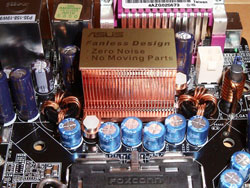
We did not manage to keep the P5AD2-E stable above 4.10 GHz with 2 F@H clients running until we directed the massive airstream of a 120 mm fan onto the heatsinks above the memory controller and the power supply. That bought us some additional MHz – at least we thought so. Unfortunately it did not help in the long run. After a couple of hours crunching 2 F@H units at 4.20 GHz the PCB obviously became so hot that the 4-pin 12-volt socket located directly beside the mosfet heatsink started to melt. Alarmed by a putrid smell we luckily had enough time to shut down the system to prevent greater damage. However, the P5AD2-E was rendered useless for further testing.
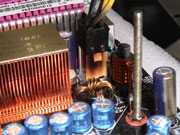 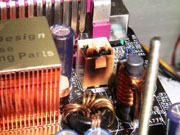 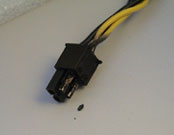
Due to our thermal mishap we could not determine the maximum stable frequency for the P5AD2-E, but it’s for sure below 4.20 GHz. That’s at least 200 MHz less than the AA8XE which was running without any such problem for 24 hours at almost 4.40 GHz. The reason is obviously the much better cooling implemented on this mainboard. The AA8XE is sporting 3 additional fans: 1x on the NB and 2x OTES exhaust fans. In addition, the mosfets have a large heatsink and the area around the CPU socket is cooled down by the OTES airstream. Under full system load, the OTES fans can become quite noisy. They can be however automatically regulated in relation to CPU and system temperature with the “uGuru” utility, a feature that comes in handy for the user who is running the system unattended over a long period of time.
CONCLUSIONS AND FINAL THOUGHTS:
The performance differences between ABIT’s Fatal1ty AA8XE, Intel’s D925XECV2 and the ASUS P4AD2-E are negligible. It seems that a few applications run a split second slower on the D925XECV2, but the difference is far too small to be noticeable. It’s therefore fair to say that the performance of these three boards is identical. We can assume this is true for most probably any other chipset 925XE based mainboard as well. Unlike a few years ago, there is basically no performance difference anymore between mainboards based on the same chipset. It seems that all manufacturers are now tuning and tweaking their products in the same way.
The more important point is that the FX55 based system was providing at a resolution of 1280 x 1024 - up to 12% more frames per second when running contemporary 3D games. However, we - admittedly not hardcore gamers - did not observe a noticeably better gaming experience. The difference becomes even smaller when running games at higher resolutions because then the frame rate is even more driven by the video card. Nonetheless: The Fatal1ty AA8XE or any other 925X chipset based board cannot claim to be the fastest gaming platform. It’s good to know therefore that ABIT offers also a “Fatal1ty” mainboard based on the nForce 4 chipset for socket 939 A64 processor.
For users that are not using their PC predominantly for gaming, general usage performance and features are more important than frames per second. And here the AA8XE definitely delivers. It takes however a rather expensive 3.46 GHz or 3.73 GHz Extreme Edition processor with a 1066 MHz system to fully exploit the 925XE chipset. But owners of a 5xx or 6xx processor that with a 800 MHz system might choose the Fatal1ty AA8XE as well to take advantage of the 925XE memory controller’s overclocking potential.
As far as features are concerned: Intel’s D925XECV2 has a few less than ABIT's Fatal1ty AA8XE, such as a second LAN controller. The ASUS P5AD2-E offers a few more, namely wireless LAN and an additional SATA RAID controller. These features however can be added to the AA8XE as PCI devices, if required, and they don’t come for free. The P5AD2-E Premium is up to 20% more expensive than the Fatal1ty AA8XE. Both the Intel and the ASUS product lack the Fatal1ty’s advanced cooling system and its BIOS sophistication. The only 2 “issues” we had with the Fatal1ty AA8XE is the lack of a 2nd IDE ATA port and the awful combination of a red PCB with pastel green heatsinks.
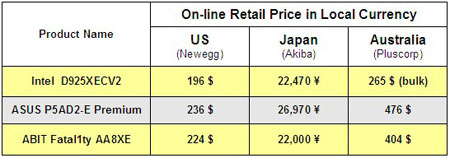
The AA8XE offers ample overclocking headroom – as we have shown the front-side-bus frequency goes to up to 345 MHz, and the AA8XE puts the user actually in the position to exploit this headroom. We don’t want to blame ASUS too much for the melt-down of our P5AD2-E; maybe we were just unlucky with our sample. When running an electronic device so far out of specification, anything can happen. The P5AD2-E Premium does not perform worse than the AA8XE and is the right choice for somebody who needs the many features that come with that product. But it’s a fact that the AA8XE comes with a much better cooling solution and thanks to OTES offers far better stability when overclocked. Even overclocked to almost 4.40 GHz and with 100% constant processor usage the system was stable for more than 24 hours. ABIT’s “uGuru” utility and its vast array of monitoring features provide the user with peace of mind when the system is running unattended. To sum it up: ABIT’s Fatal1ty AA8XE offers top performance, huge overclocking headroom and comes for a fair price. The superior thermal stability provided by the OTES cooling system makes the Fatal1ty AA8XE the perfect product for distributed computing or similar projects requiring the system to run 24/7 under heavy load.
ABIT products are distributed in Australia by Altech Computers.
|
|
Advertisement:
All original content copyright James Rolfe.
All rights reserved. No reproduction allowed without written permission.
Interested in advertising on OCAU? Contact us for info.
|

|


